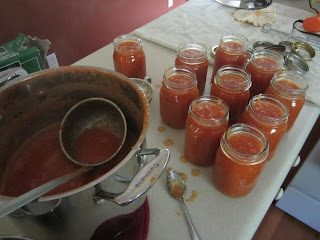This is the only recipe that my mom kept from all the years of canning she did when I was a girl. It is a family heirloom recipe that I am willing to share with readers because it is simple to make and very tasty!
When my family decided to quit dairy farming and move to town I was 8 years old. All of the canning supplies were sold at the farm auction and my mom didn't think twice about giving up that way of life. We were moving to a small lot that was mostly shaded and growing a garden wasn't feasible. Besides the lack of growing space in town, I recently asked my mom why she discontinued canning when moving off the farm because last year she decided to begin canning again after a 20 year break. Her response was quite simply this, "Canning food decades ago was a way of life for families living in the country. I didn't feel like I had a choice on whether to grow a large garden and preserve food. At that time it was to our financial advantage to grow and can our own food and there wasn't all of this hype about GMO's, pesticides, fertilizers, and food quality. Now that health is a concern nowadays, I feel it's important to know where our food comes from and how it's grown. Today it's not necessarily financially cheaper to grow and preserve food so it's more of a personal choice and lifestyle for most families." What an interesting perspective about how something like canning is "back in style" but for different reasons.
Tomato Soup:
1 peck tomatoes (12 pounds)
3 large onions
3 green bell peppers
small bunch of celery (~4 stalks)
dry mixture:
1 cup sugar
1 cup flour
scant 1/3 cup canning salt
Can and seal: pints 5 pounds for 10 minutes
Canning Tomato Soup
Labels: Preservation , Recipes
Nylon Rope Never Breaks
Sunny days have been pretty irregular this month so laundry is done in spurts when the clothesline can be used. There is something satisfying about drying laundry outside and I just love the feel of clean, air-dried sheets on the bed. Many people complain about the "crunchy" feel of towels dried on the clothesline but we are definitely not going to use fabric softener. For one thing, we don't need added synthetic perfumes in fabric rubbing against our skin; and second, it's kinda creepy knowing that fabric softener contains a lot of ingredients that make fabric cling-free and wrinkle-free. I don't want all that stuff embedded in my clothing and towels.
Yesterday I was hanging up the few remaining items in the basket when all of a sudden SNAP! The freshly washed laundry was now lying on the just mowed grass. The nylon rope that has held the clothesline up for 18 months has finally broke and according to my father in law, "Nylon rope never breaks!" Well, it does after 18 months in the sun and rain. How did we remedy the problem? We grabbed a thicker rope from the barn that the previous owner left behind.
Labels: Cleaning , Conservation
Honeybee Behavior in Summer Heat
I had intended on posting this back in July but it seems this post got buried among everything else.
During the hot and humid spell in early July I noticed 2 things:
1. One hive bearded significantly more than the other.
2. Honeybees were seen motionless on flowers in the evening.

I'm not sure if this behavior can be contributed to the heat or if the flowers they were visiting were poisonous? I tried identifying the flower but couldn't find an exact match. These were the only flowers I noticed they were visiting. Both hives have a large population of bees and I didn't notice any nosema so I don't suspect disease but it's hard to be sure of that.
The blue hive definitely drew more beards than the other hive in the evenings. The bees form a beard to help cool down the hive. What's interesting is when I took a picture underneath each hive, the blue hive had more bees outside the screen; perhaps this has something to do with the bearding? The white (Warrior) hive only has a few bees outside the screen. The white hive also has an extra super which could also contribute to the lack of bearding because they have more space.
 |
| White (Warrior) Hive |
 |
| Blue Hive |
 |
| What's left of the beard in the morning. |
Labels: Bees
Honey Harvest 2013
Labels: Bees
































